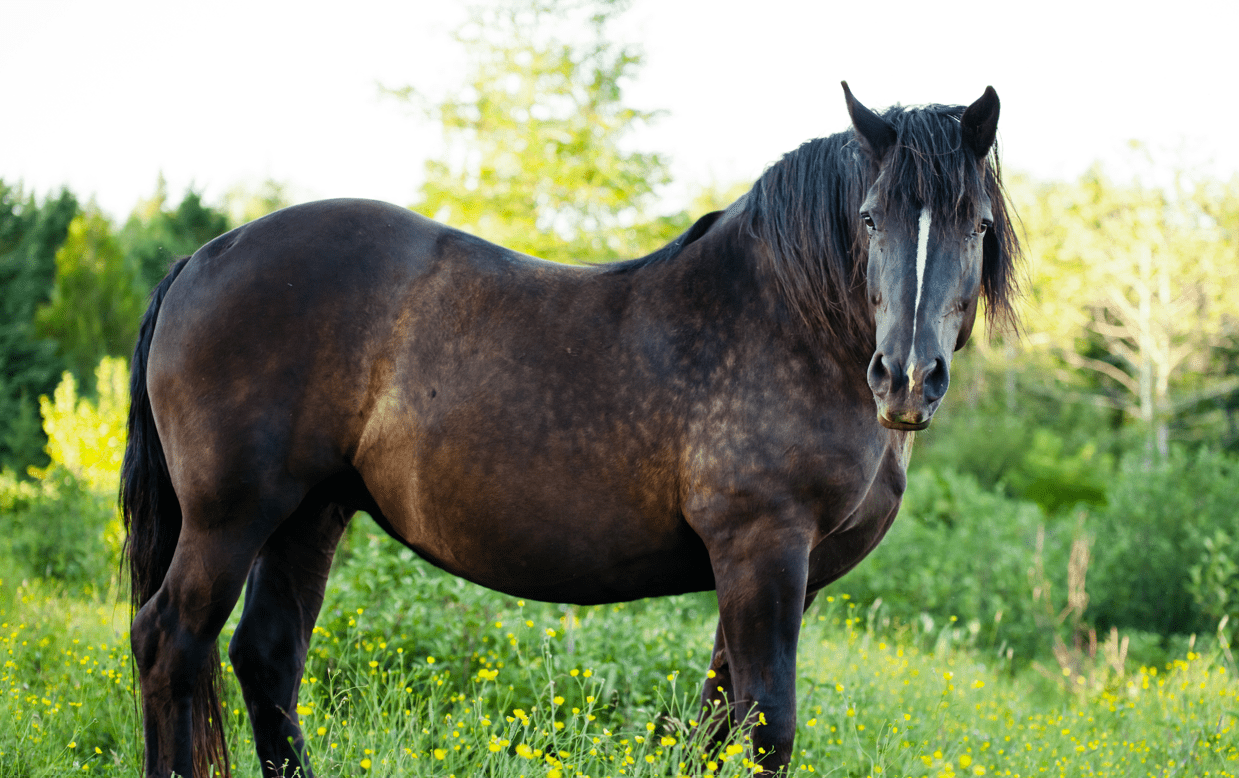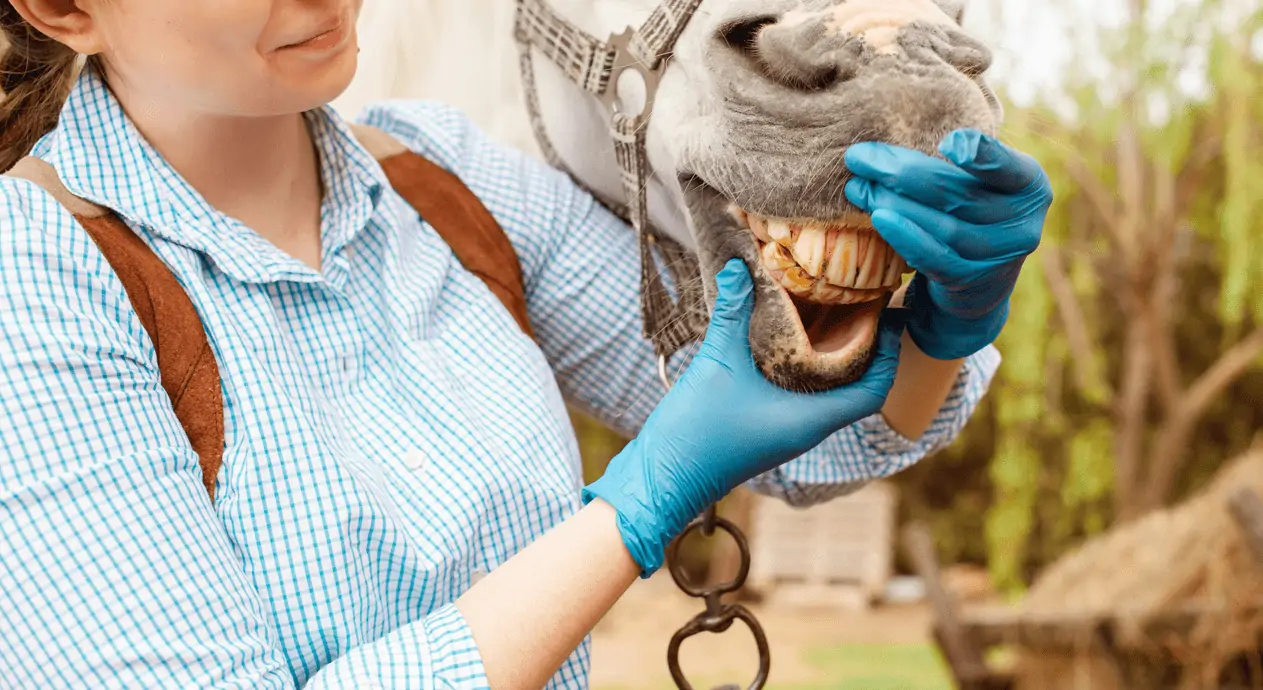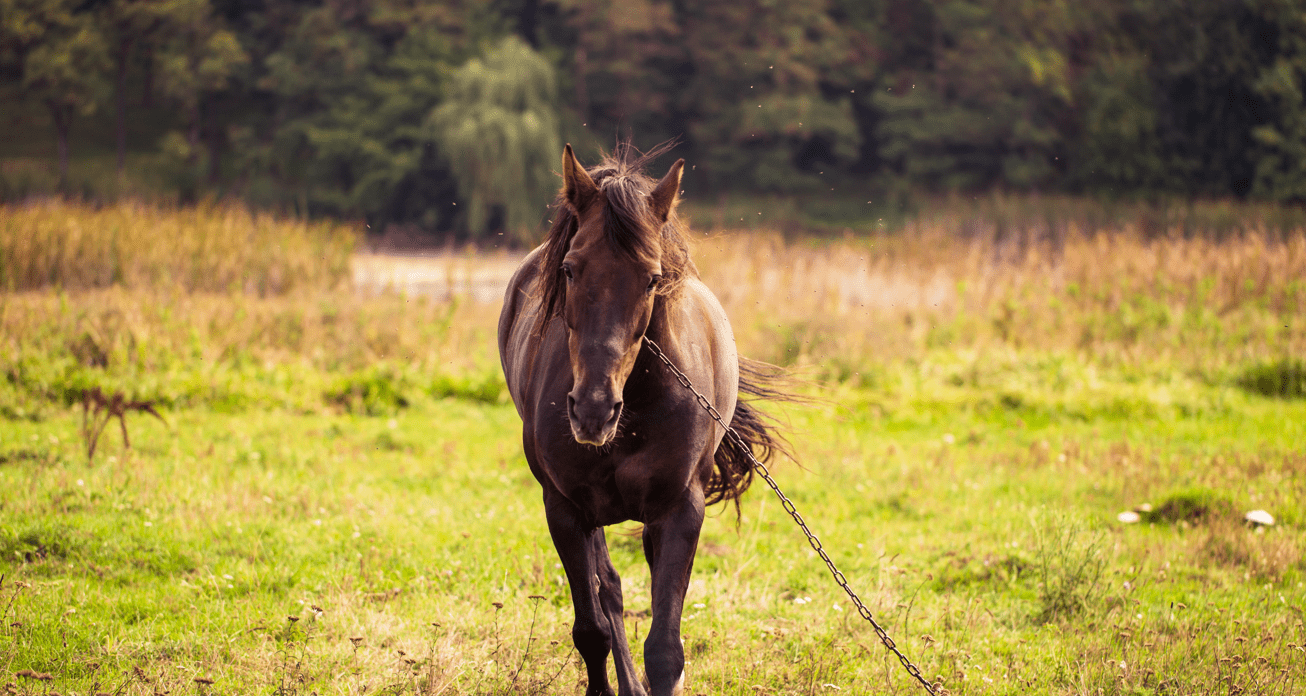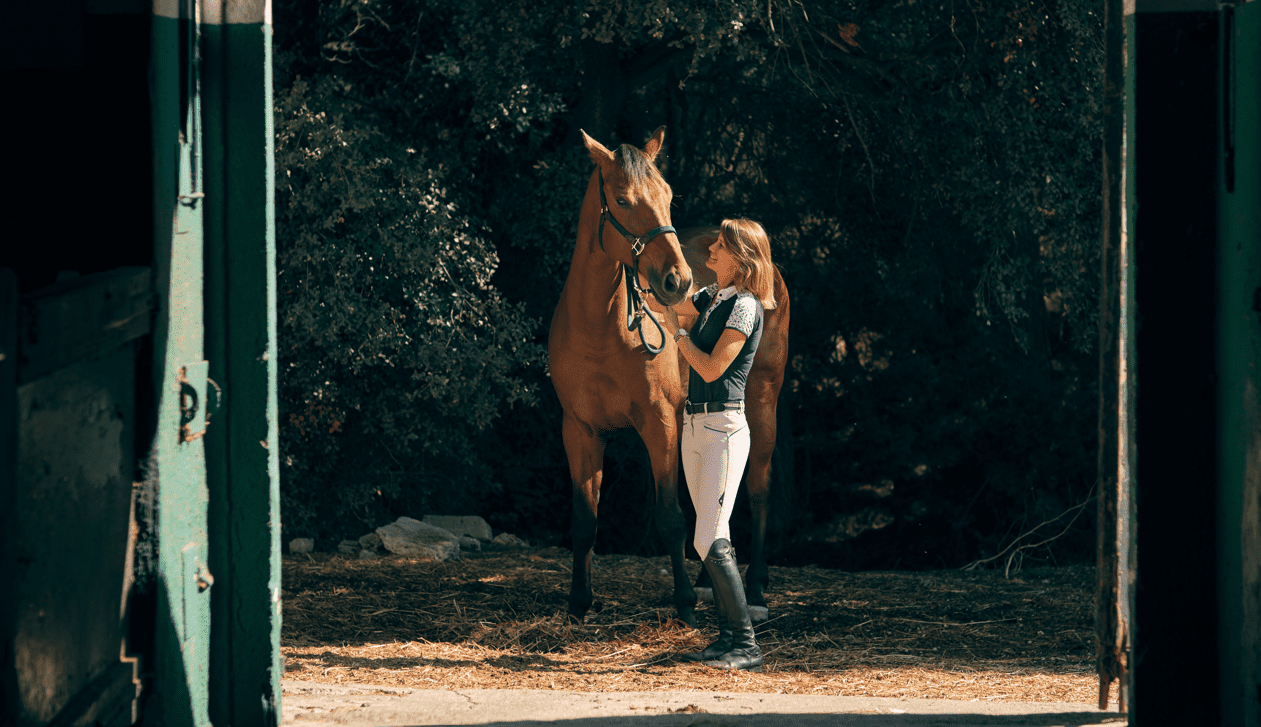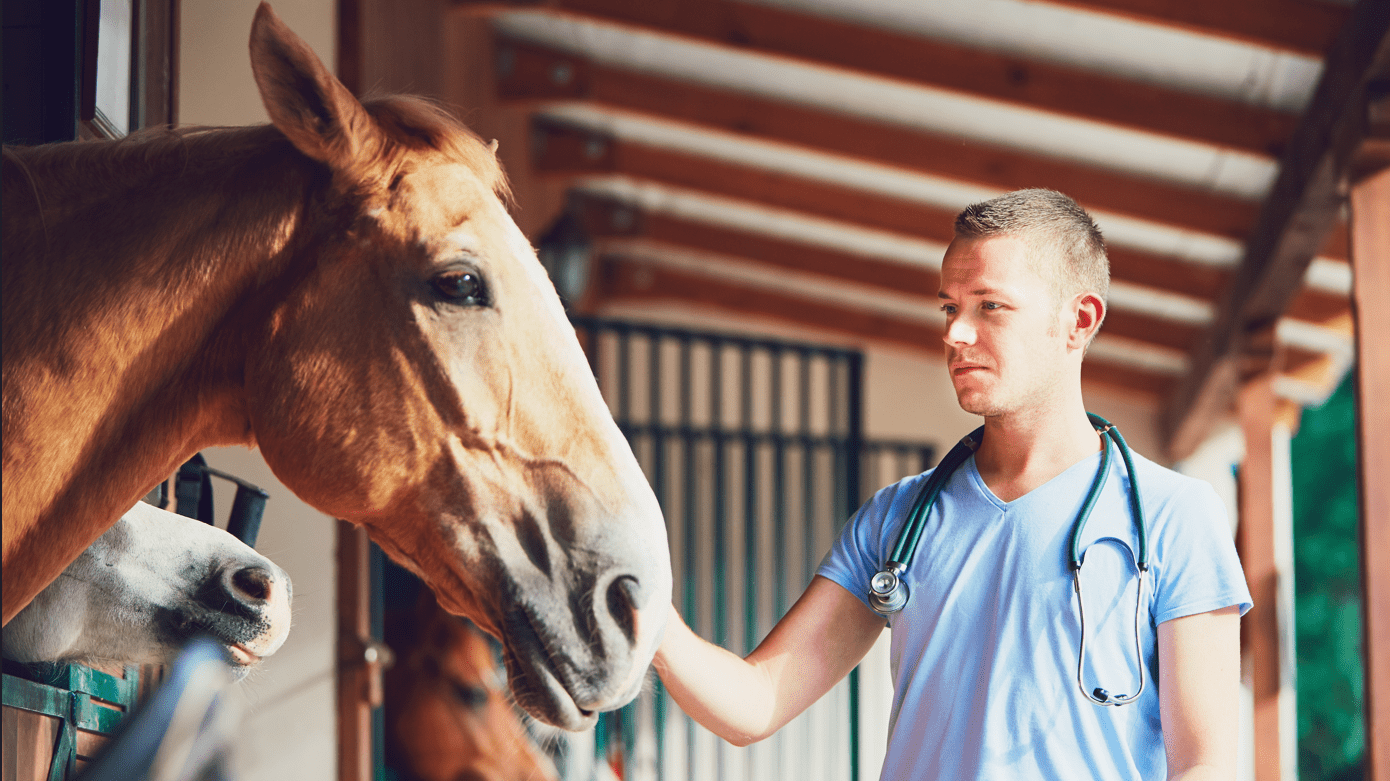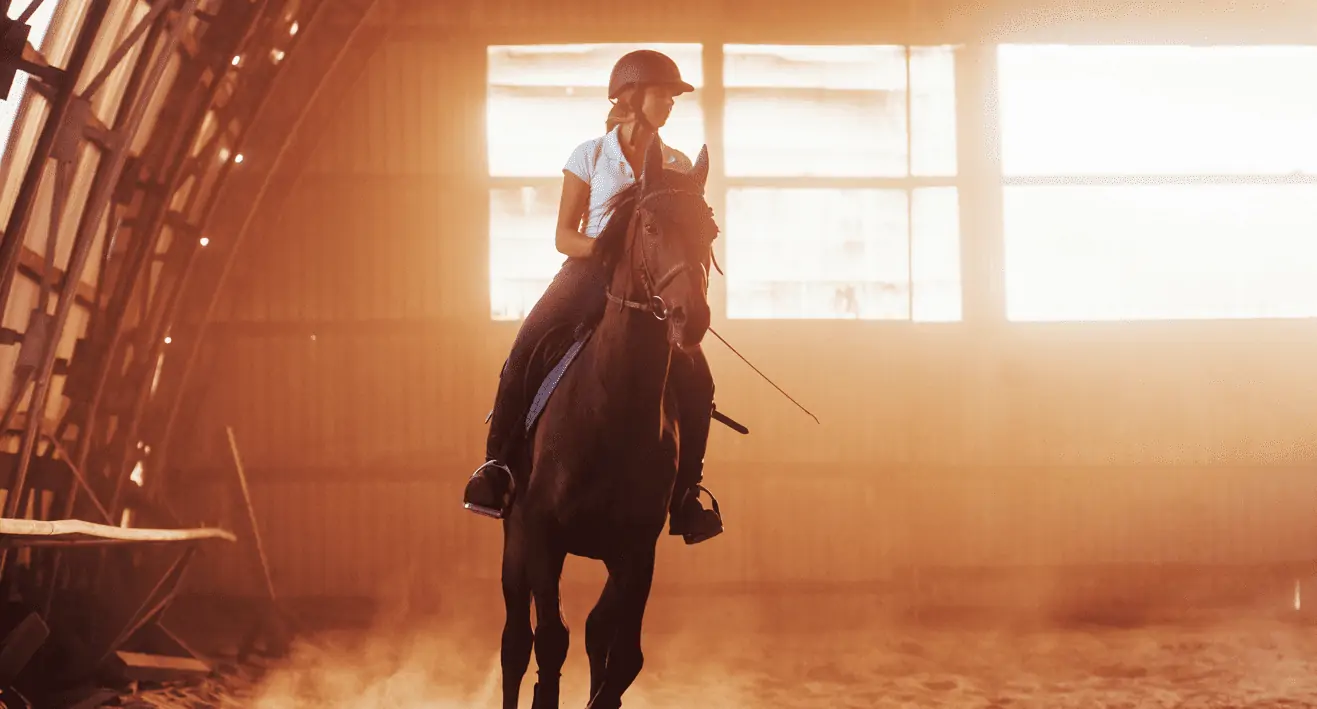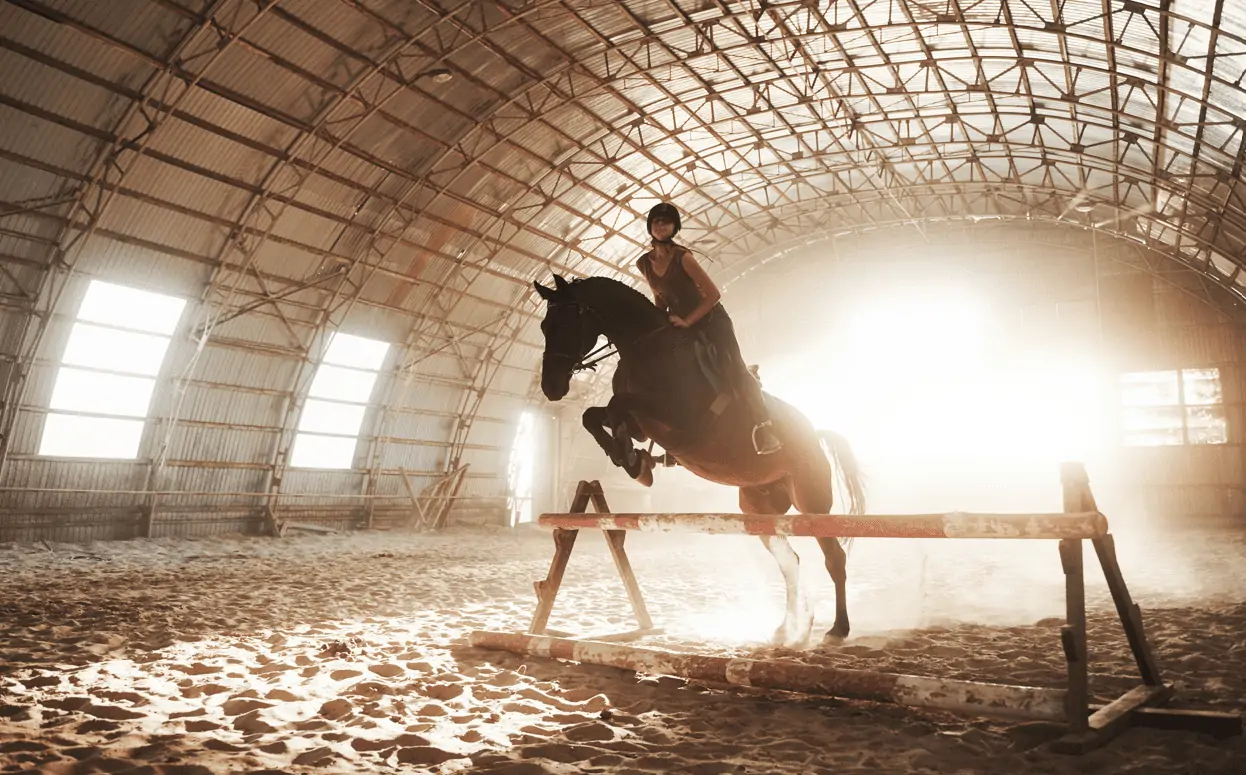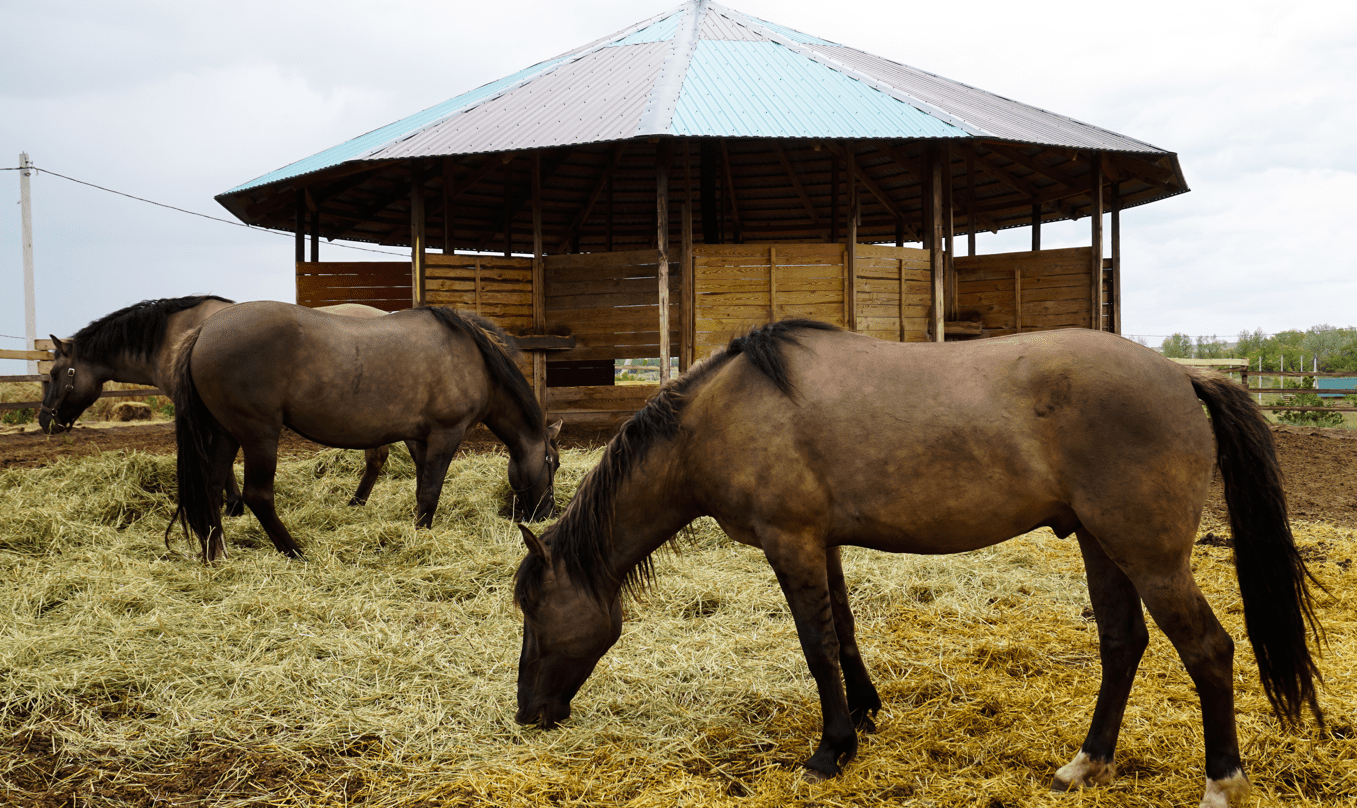- What is a Gaited Horse - October 5, 2023
- What to Look at When Getting a New Farrier - September 21, 2023
- Best Horse Feeds for Older Horses - September 21, 2023
- What Is a Stallion Horse?
- Bottom Line About Stallions
- Stallion Horses Explained
- Unique Physical Characteristics of a Stallion Horse
- Behavior Traits of a Stallion Horse
- Basic Stallion Horse Care
- Diseases Affecting Stallion Horses
- Training a Stallion Horse
- Riding, Driving, Jumping, and Showing a Stallion Horse
- Owning a Stallion Horse: Responsibilities, Liabilities, and Realities
- The Cost of Owning a Stallion Horse Explained
- FAQs
- The Last Stallion Thoughts
As a little girl, I had always dreamed of owning a stallion horse, ever since I watched the Black Stallion movies. However, my first riding instructor had a horrific incident where she was attacked by a stallion while riding her gelding. To say she was severely injured is putting it mildly. Since then, I had been somewhat scared of being anywhere near a stallion.
Years later, my farrier bought a huge Friesian stallion, and this gentle giant (all 17 hands of him) ultimately won me over, and I got over some of my fear of stallions. That said, a stallion is a horse that requires respect, special handling, knowledge, experience in training, and careful management.
With some personal training, I am now able to handle Alfonso, and I can confidently lead this prime stallion when necessary. And believe me, there is something quite intimidating about being next to such a powerful horse that reacts so much differently to mares and geldings.
If you’ve ever wanted to know about stallions, whether you should get one, if you should let your horse remain a stallion, and what the risks and benefits of a stallion are, I’ve got all the information right here for you.
What Is a Stallion Horse?
A stallion is a male horse that is “intact,” where their testes have not been removed during the gelding process. When a male horse is born, they are considered a colt up to the age when they start to reach sexual maturity (usually age four). However, this age depends on the horse breed as some horses mature later than others.
Usually, if a colt is not intended for breeding purposes, it is often safer and better to have them castrated or gelded before they are a year old to prevent unplanned breeding. A vet usually performs the gelding process. The colt’s testes are cut open while under anesthesia, and the contents are removed. The colt can no longer produce viable sperm to impregnate a mare.
The gelding process also reduces the amount of testosterone hormone the colt can produce, making them more easily managed and even-tempered. After the procedure, it is advisable to still keep the gelded colt away from mares as there may still be some viable sperm cells that have not yet been expelled. After eight weeks, the horse is considered a gelding.
Bottom Line About Stallions
Stallions are large, beautiful, and incredibly full of life. However, they are not for everyone to own. Responsible ownership of a stallion requires knowledge, proper training, and suitable facilities to manage them. Poorly trained stallions can be REALLY dangerous.
Stallion Horses Explained
As a trainer, I always caution my students about buying a stallion as their first horse. Sadly, there are many stallions for sale, and with their beauty, they often fetch a handsome price. Most stallions are not correctly trained and handled, making them a dangerous prospect for anyone still learning about horses, their care, and management.
Here are a few essentials you should know about stallions if you’ve ever thought about getting one or leaving your young colts ungelded.
Unique Physical Characteristics of a Stallion Horse
Due to the growth hormone, which is also the sex hormone of stallions, they develop into much bigger and more muscled versions of male horses. In nature, the stallion would need the extra size and height to dominate other stallions and win his own herd of mares.
The Stallion Crest
One of the first things you’ll see with a stallion is their neck muscles. The neck usually has an exaggerated bend, from prancing to impress the girls! This neck muscle at the top of their neck is what forms the stallion crest.
The overdeveloped neck muscle in a mature stallion adds to their overall size and presence. As a result, the stallion will also develop a much thicker neck than a gelding or a mare. When a stallion is gelded later in life, they usually retain their crest unless they are overweight and then lose the neck muscle with their body weight as soon as their hormone levels become lower.
Thicker Shoulders
Since a stallion has a much bigger and heavier neck, they need to develop shoulder strength to carry that weight. The result is much broader and heavier shoulders. The more prominent shoulders are also useful to the stallion when mating with a mare. A stallion’s strength is required to mount the mare when breeding.
Stronger Legs
A mature stallion will also develop strong legs with which to run and fight off other stallions that may try to steal his mares. By kicking and rearing up, the stallion asserts his dominance.
Stallion Teeth
Stallions may develop an additional set of teeth that have an evolutionary function when biting other horses when he defends his herd from attack. These tushes are located about a finger width behind the last incisor teeth. The bottom jaw’s stallion or wolf teeth erupt when the male horse is four years old. A set on the top jaw follows soon after.
If your stallion is a ridden horse, these wolf teeth may need to be removed or filed back to ensure the bit can fit comfortably in the horse’s mouth. Should the bit press against the wolf teeth, it will be painful and can lead to behavior issues.
Behavior Traits of a Stallion Horse
Stallions are more aggressive, dominant, and confrontational than other horses. Unlike mares and geldings, stallions have the brute power to break through fences, jump over stable doors, and kick their way out of confinement.
Even simple activities like grooming, leading, or bathing a stallion can become dangerous if they are not well socialized and trained for obedience. Yet, so few horse owners take the time to train a young colt from the start to develop into an obedient and safe-to-be-around stallion.
Basic Stallion Horse Care
Stallions require additional care, especially if they are kept for breeding purposes. First-time stallion owners should know about a few other considerations regarding their care.
1. Environment and Separation
Since a stallion is dominant, it’s rare to keep them in a herd situation. Some stallions, if well socialized, can be kept with young colts or older geldings. However, most stallions have to be pastured in isolation.
The grazing paddock where the stallion grazes has to be correctly fenced as regular split pole fences will not contain a stallion if they desire to get out. The best type of fencing for a stallion is electric fencing specially designed to keep horses, also known as a strip-grazer.
The electric fence should be set up with a minimum of three lines to ensure the stallion doesn’t jump or duck under the fence. Evenly spaced poles to keep the fence correctly installed are also a significant requirement.
2. Stabling
When kept in a stable yard, the stallion should be kept in a stable with a solid door, which is kept locked to ensure the stallion doesn’t slide the door open. If a herd of horses comes to their stables at liberty each day, then there needs to be a top door to the stallion’s stable to ensure he doesn’t jump over or try to bite other horses as they pass. Even if the other horses are led in, keeping the stallion secured with a closed top door is still better.
3. Daily Handling
Always lead stallions to and from their grazing paddock. Only knowledgeable persons who have been trained on how to handle stallions should be allowed to lead the stallion. The stallion should only move from their stable to smaller corals or paddocks when there are no other loose horses.
Do daily grooming in the stable, where the stallion can’t move about or get excited. For dangerous stallions, setting up cross-ties is a good safety precaution.
4. Cleaning Before Coverings
When stallions cover mares, consider certain checks. Firstly, you should clean the sheath and phallus of the stallion and the mare’s vulva to ensure there is no chance of contaminants entering the mare’s uterus. Infections can lead to abortions and severe complications for the stallion.
Perform health checks for the stallion to ensure he doesn’t have any sexually transmitted diseases. The mares also need to have an inspection done by a vet and biological samples sent to a lab to test for diseases.
A professional usually cleans the stallion’s sheath and phallus at a breeding yard, but owners can learn how to do it themselves. Here’s the basic method, but be aware that not all stallions will allow their “bit ‘n tackle” to be cleaned or touched if they aren’t trained. The solution is to prepare a stallion from the age of a colt to accept human touch in these very sensitive areas.
Top Tips: Cleaning a Stallion’s Sheath and Phallus
Ensure a knowledgeable helper is holding the stallion in cross-ties. Have all the necessary equipment handy as listed below:
Supplies
- Warm water
- Small, soft sponge (that doesn’t flake off easily)
- A sheath cleaner like Excalibur Sheath Cleaner
- Towel
- Surgical gloves (at least 6mm thickness to prevent tearing)
Method
- Wear the surgical gloves, moisten the sponge, and begin cleaning the outside of the stallion’s sheath.
- Add a small amount of the sheath cleaner to the sponge. Massage into the sheath, the folds of the sheath, and around the area of the urethra where a collection of smegma may form a “bean.”
- Rinse well with the sponge and water, gently scrubbing to remove smegma deposits and dead skin.
- Using your moistened hand, insert the hand into the sheath, gently but firmly pulling the penis out to clean the hidden pouch around the penis with warm water that contains a few drops of sheath cleaner. Don’t apply too much sheath cleaner; rinse well before letting the sheath dry.
Suppose you prefer to work with only warm water to clean the stallion’s penis before a covering or mating. In that case, this is also perfectly okay, but never use soap as this will destroy the delicate natural bacterial balance in the sheath.
Diseases Affecting Stallion Horses
Mostly, a stallion horse requires the same health care as other horses, including regular deworming and vaccinations against viral diseases. However, there are also a few diseases that stallions can contract, and these require extra care:
1. Contagious Equine Metritis (CEM)
Stallions used for breeding purposes are required to get a CEM test at the start of the breeding season. The CEM test is obtained by having a licensed veterinarian collect four different swabs from the stallion’s penis and sheath. Send these swabs to a registered lab for testing.
Use antibiotic treatment should the stallion test positive and keep him out of the breeding cycle until he tests negative. This can take months, and the loss of time to breed mares may cost the stallion owner dearly. Registered stallions with a high pedigree earn their owners a large fee for coverings, and being unable to do so will mean a loss of income.
2. Equine Viral Arteritis (EVA)
EVA isn’t lethal to healthy adult horses, though mares often abort their pregnancies if this virus infects them. The virus spreads through mucus, droplets in the air, and also through contaminated semen.
Since EVA tends to be subclinical, the mares and stallions used for breeding need to be tested to confirm a diagnosis of EVA. Antibiotic treatment will help clear up the disease.
However, the real threat is keeping a herd of young foals at foot with their dams with other pregnant mares (who may be the carriers). The young foals are especially susceptible to contracting the disease, and fatalities are frequently the result.
Therefore, infected mares and stallions should be kept separate from healthy horses. Transmission of the disease can also happen with contact with contaminated mucus. So, wearing protective clothes and covers by those who work with breeding horses when moving between breeding facilities is essential to limit the spread.
3. Equine Herpesvirus 3 (EHV-3)
Horses infected with EHV-3 usually show external signs like lesions on the stallion’s penis and around the mare’s vulva. The internal effects of the virus are like other herpesviruses. The stallion and any sexually infected mares may develop EHV-3 and painful lesions. While mares don’t usually abort their foals if covered by a stallion with EHV-3, the foals are often born with lesions around the muzzle that could lead to secondary infections.
Other strains of EHV (numbered from 1 to 5) can be more lethal than EHV-3. EHV-1 can have neurological complications from which the horse may not recover. EHV-3 is the variant that transmits via semen and physical contact during breeding.
Training a Stallion Horse
While some breeders don’t put much effort into training their stallions beyond basic ground manners, stallions have a lot of potential as show horses. An added benefit of training a breeding stallion to perform in the showering is that the stallion builds a reputation for their abilities, which is passed to their offspring.
Hence, people seek breedings for their mares by stallions known to be excellent show horses, jumpers, and racehorses. Training the stallion to perform when surrounded by distractions can be a challenge.
While writing about how to do advanced stallion training is a bit outside the scope of a single article, there are some essential elements you can use when training basic obedience into your young colt that you are considering keeping as a stallion.
Be Consistent
Stallions, and other horses, require consistent handling. If you don’t allow your young stallion to prance next to you when leading, then that should be your rule for each day. Don’t confuse the stallion by laughing at their prancing today and then punishing them tomorrow for doing the same behavior.
Be Patient and Avoid Conflict
With stallions, given their size and ability to become aggressive, it’s advised that you plan to avoid situations where you will have conflict. So don’t lead your young stallion next to a paddock filled with frisky mares—you’d be looking for trouble if you did.
Be patient in how you ask for things, but don’t accept disrespect and aggressive behavior from your stallion. As soon as they start misbehaving, appropriately correct them. BEFORE the stallion rears up and charges another horse, correct his behavior with a gentle tug on the stallion chain or the bit if he’s in a bridle.
Select Who Works With Him
Letting just anyone work with or lead your stallion is never a good idea. One bad situation where the stallion breaks free and runs can create months of challenges. Choose qualified and trained people to work with your stallion.
If you are considering the purchase of a stallion, then I’d advise you to go for training at a breeding facility. These professionals will instruct you on the best way to handle a stallion and advise you on what to do when things get out of control.
Remember: An untrained stallion is an unpredictable and potentially dangerous animal. Invest the time and resources to train your stallion to ensure they won’t suffer abuse and pain in the future.
Riding, Driving, Jumping, and Showing a Stallion Horse
Much of the training a stallion undergoes to make them into a performance horse is similar to what a mare or gelding would experience. However, when training a stallion for riding disciplines like show riding, dressage, jumping, equitation, and racing, extra care should be taken to ensure the stallion remains disciplined and respectful.
Since you are controlling a much stronger horse when working with a stallion, special “stallion” bits are used for stallions, but they can also be ridden in a snaffle bit. While a well-trained stallion can be ridden in a rope halter by an experienced rider, most stallions require heavy-duty equipment for halters, bits, and other restraining tack.
Owning a Stallion Horse: Responsibilities, Liabilities, and Realities
You’ve just bought a stallion. Congratulations! Hopefully, the stallion has been well-trained, but chances are that he hasn’t. If you consider keeping him in a paddock until you chase a mare in to be covered, you should take note of your responsibilities as a stallion owner.
Breeding your stallion will require you to take precautions to ensure he doesn’t hurt the mare and that she doesn’t kick and potentially kill him. Handling a stallion excited by a mare’s presence can be dangerous to the handler.
An aggressive stallion may attack people who walk past him or if they tease him. Therefore, manage your stallion correctly by taking these steps:
- Post warning signs that he is a stallion and no touching is allowed.
- If you have electrical fencing around his paddock, post caution signs to prevent people from getting a shock if they try to climb the fence.
- If attending shows, braid a blue ribbon into the stallion’s tail to ensure other riders know not to come too close to him in the warm-up arena.
- Arrange beforehand with the organizers of shows that you are bringing a stallion. Some shows won’t allow stallions to enter.
- Have a portable electrified paddock to keep your stallion in between classes or after the show while you load up. Having a groom always stay near the stallion is also a great idea.
The Cost of Owning a Stallion Horse Explained
If you’ve never owned a stallion before, you are in for an expensive adventure. Keeping horses is often more expensive than the once-off cost of buying a stallion. Stallions require additional care, and this can be expensive.
The electric fences, vet bills, groom fees, and specialized equipment all add up to make for an expensive hobby. While you may reason that a registered stallion (or stud) can help pay their keep with coverings, it is often not the reality.
If your stallion is kept at a public stable yard or if you frequently attend shows, it is also advisable to get public liability insurance for your stallion. For prize stallions, getting horse insurance is also a great idea. Should your horse become ill or be injured, the insurance will pay the value of your policy to replace the financial loss.
FAQs
Answer: A stallion is a male horse that can reproduce offspring by mating with female horses or mares. A horse is the broader term for any member of the equid species, such as a stallion, mare, colt, gelding, or filly.
Answer: Stallions that have been trained can be ridden. Since they are bigger and stronger than other horses, stallions can be aggressive, so their riders need to be confident and know how to handle a horse that gets difficult.
The rider’s skills become extra important when they ride the stallion with other horses on a ride.
Answer: Keeping a stallion requires the knowledge and facilities to keep the stallion responsibly. Unlike mares and geldings, which tend to be much more relaxed and docile, stallions can be a real challenge to keep. Stallions have different hormonal drives, which can make them aggressive, dominant, and unpredictable.
Answer: When calming a stallion that is getting worked up, it is essential to remain calm and not become confrontational. So if the stallion is starting to prance next to you on the lead, stop the behavior by continuing to walk at a moderate pace, keeping the stallion’s attention on you.
Talk in soothing tones, flex the stallion’s neck slightly to get their focus back on you if they see other horses. Don’t give the stallion too much room to move, but don’t crowd them.
Answer: When correctly socialized, young colts can continue to live together in a paddock. In the wild, young stallions band together until they can each gather their own harem of mares. If the stallions have known each other from a young age, they can continue to live together if there are no mares or other horses nearby or in the adjacent paddocks. The presence of mares will create a problem, and the stallions will fight.
The Last Stallion Thoughts
Stallions are magnificent animals, and they embody everything I love about horses: power, speed, pride, and beauty. However, having worked with stallions and assisted my farrier with her mild-mannered stallion, I know I am not ready to keep a stallion myself.
The cost of keeping a stallion correctly far outstrips my resources. So while I love stallions, I don’t think I’ll get one just yet. If you are considering getting a stallion, ensure that you are fully informed about your stallion and how to keep it correctly.



